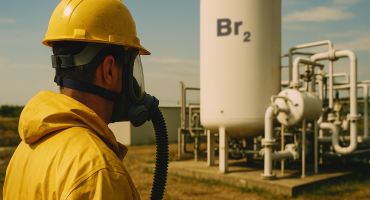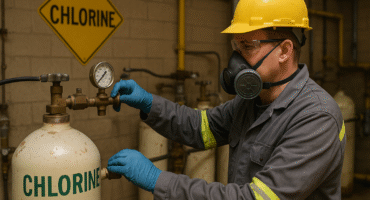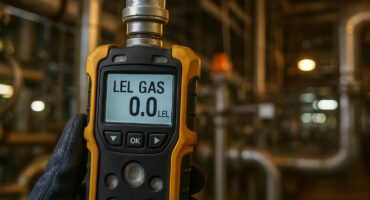In various industrial sectors, the presence of poisonous gases poses significant health and safety risks to workers and the surrounding environment. For industry professionals and safety officers, understanding the nature of these hazardous substances is crucial for implementing effective safety measures and preventing accidents. From semiconductor manufacturing to water treatment, the diverse applications of these gases necessitate a comprehensive approach to their detection, handling, and mitigation.
This article aims to provide an overview of the most dangerous gases encountered in different industries. By highlighting their potential risks, the industries in which they are commonly found, and the appropriate gas detectors required, we seek to enhance awareness and promote safety protocols among professionals.
We’ve also created a List of Poisonous Gases and Harmful Chemicals in PDF format for a detailed reference.
Understanding the key risks associated with highly toxic gases is crucial for ensuring workplace safety. Here is a concise list of the primary hazards:
By understanding these risks, industry professionals can take appropriate measures to protect against the hazards associated with these highly toxic gases.
Different industries face specific risks associated with various toxic gases, necessitating tailored safety measures for each sector:
| Industry | Risks | Associated Gases |
| Electronics and Semiconductor | Toxic exposure, respiratory issues, explosive hazards | Arsenic pentafluoride, Arsine, Boron trifluoride, Diborane, Dichlorosilane, Germane, Phosphine, Tungsten hexafluoride |
| Chemical Manufacturing | Corrosive effects, toxic exposure, respiratory issues | Bis(trifluoromethyl)peroxide, Boron tribromide, Boron trichloride, Chlorine pentafluoride, Chlorine trifluoride, Cyanogen, Diazomethane, Formaldehyde, Hydrogen fluoride, Perfluoro isobutylene, Phosgene, Phosphorus pentafluoride, Selenium hexafluoride, Silicon tetrachloride, Silicon tetrafluoride, Sulphur tetrafluoride, Tellurium hexafluoride |
| Water Treatment | Corrosive effect, respiratory issues | Bromine, Chlorine, Bromine chloride |
| Agriculture | Toxicity, respiratory issues, even fatality | Bromomethane, Chloropicrin, Phosgene, Sulfotep, Tetraethyl pyrophosphate |
| Metal Processing and Refining | Toxic exposure, fatality, respiratory issues | Arsine, Hydrogen cyanide, Nickel tetracarbonyl |
| Petroleum Refining and Natural Gas | Toxic exposure, respiratory issues, explosive hazards | Hydrogen sulphide, Hydrogen selenide |
| Healthcare and Sterilization | Carcinogenic properties, respiratory issues, toxic exposure | Ethylene oxide, Formaldehyde |
| Research and Laboratories | Carcinogenic properties, neurological damage, toxic exposure | Dimethylmercury, Hydrogen azide, Osmium tetroxide |
| Automotive and Combustion | Toxic exposure, respiratory issues, fatality | Carbon monoxide, Nitrogen dioxide |
| Military and Chemical Warfare | Highly toxic, respiratory issues, fatality. | Cyanogen chloride |
Here are some of the most dangerous gases encountered in various industries, highlighting their key dangers and associated sectors:
| Gas | Chemical Symbol | Key Dangers | Industry |
| Arsine | AsH3 | Highly toxic, hemolysis, can be fatal | Semiconductor, metal processing |
| Carbon Monoxide | CO | Highly toxic, oxygen deprivation, can be fatal | Various, including automotive, industrial |
| Chlorine | Cl2 | Highly toxic, corrosive, respiratory issues | Water treatment, chemical industry |
| Cyanogen | (CN)2 | Highly toxic, can be fatal | Chemical synthesis |
| Hydrogen Cyanide | HCN | Highly toxic, interferes with respiration, can be fatal | Metal refining, fumigation |
| Phosgene | COCl2 | Highly toxic, respiratory issues, can be fatal | Chemical manufacturing, pesticides |
| Dimethylmercury | (CH3)2Hg | Highly toxic, neurological damage, long-term fatality | Chemical synthesis, laboratory |
| Ethylene Oxide | C2H4O | Highly toxic, carcinogenic, explosive | Sterilization, chemical synthesis |
| Nickel Tetracarbonyl | Ni(CO)4 | Highly toxic, carcinogenic | Chemical manufacturing, metal refining |
| Osmium Tetroxide | OsO4 | Highly toxic, corrosive, severe eye and skin damage | Chemical manufacturing, laboratories |
For a detailed list of harmful chemicals, please see our PDF download available at the end of this article.
To protect workers and the environment from the hazards of poisonous gases, industry professionals and safety officers should implement the following key safety measures:
By following these safety measures and using appropriate detection methods, professionals can significantly reduce the risks associated with poisonous gases and ensure a safer working environment.
Effective detection of poisonous gases is crucial for industrial safety. Common detection methods include:
Implementing these detection methods helps professionals significantly reduce risks and maintain a safe working environment.
Poisonous gases in industrial environments pose significant health and safety risks. This article highlights the dangers of various toxic gases, their industrial applications, and essential safety measures to mitigate these risks.
By being aware of potential presence and dangers of various gases, as well as implementing necessary measures and equipment, industry professionals can protect workers, prevent accidents, and ensure regulatory compliance. Additionally, a well-informed and prepared workforce, through continuous education and regular safety drills, is essential for managing the risks associated with poisonous gases and maintaining a safe industrial environment.
We encourage you to download our comprehensive List of Poisonous Gases and Harmful Chemicals in PDF format for a detailed reference.
From the Blog



If you have any questions about our products or services, please feel free to contact us.